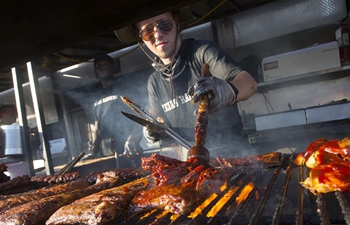By Xinhua writer Xia Lin
NEW YORK, July 1 (Xinhua) -- Several white men gathered at the gate of a small noodle shop at noon in midtown Manhattan, chatting about office affairs while waiting for mouth-watering hand-pulled Chinese noodles to be served.
Like many of the white collars in New York City trying to survive another day of stress at work, they came, along with their Asian peers, to Tasty Hand-pulled Noodles II, located on 9th Avenue, for a bowl of spicy and delicious noodles.
At this simply decorated but locally revered restaurant, diners can find a wide spectrum of dishes to order from. Just for noodle soups alone, there are 25 varieties, with "vegetable and egg noodle soup served with choice of broth and noodle" served as the top choice at 8.50 U.S. dollars per bowl.
"I personally recommend the beef noodle soup with knife peeled noodles, pan fried noodles with fat noodles, or any of their dumplings," wrote Kevin C. from New York on www.yelp.com.
The restaurant's chef has five ways to shape flour noodles: regular hand pulled (HP), fat HP, small wide HP, big wide HP and knife peeled. Regular or skinny rice noodle and potato glass noodle are also available, for eaters preferring soft chewing.
"These knife cut noodles had awesome texture. In some ways, it almost didn't matter what specific other things came along with the noodles. I was just happy chewing away at the wide ribbon," said Jennifer Che on www.tinyurbankitchen.com.
LEGEND AND MIRACLE
Hand-pulled noodles have been a craze in Big Apple as dining spots were established one after another, featuring their delicacy and unique craft of making.
Though they were usually "tucked away in a small side street" and "typically hole-in-the-wall in Chinatown" with colorful sign beckoning customers into "a reasonably cramped eating space with simple wooden tables and pictures of dishes on the walls," as Che described in her web post, legend and miracle frequently popped up out of the wet and sweaty operation.
Liu Haokun was born in the 1990s in China's northwestern Gansu Province, where hand-pulled noodle originated and its para-shrine status in the culinary industry has been maintained for generations.
After graduation from New York University, sensing hand-pulled noodle's popularity, Liu returned to Gansu and learned for half a year how to pull noodle by hand. Back to New York City, he opened his own noodle restaurant, soon making 8,000 to 10,000 U.S. dollars a day with each bowl of noodle sold at eight to 15 dollars. Currently, he is mulling to open more branches to maximize incomes and profits.
"It's already China's No. 1, and I want to make it the world's No. 1," said Liu.
Earlier this week, China News Service quoted Roy Ying, President of the NYC-based U.S.-China Sister City Association (UCSCA), as saying that he planned to open three hand-pulled noodle restaurants in 2018 in America, Canada and Mexico.
He made the decision after paying a visit to Lanzhou, capital city of Gansu, where he met with noodle-making gurus and catering industry VIPs.
He set a target to open 10 more Chinese noodle dining spots in 2019 and ultimately extend the franchise to 100 branches.
"Let the North American youth know about China through noodles," said Ying.
PROLIFERATION
Hand-pulled noodle is also called Lamian as its Chinese pronunciation. It is made by twisting, stretching and folding the dough into strands, using the weight of the dough. The length and thickness of the strands depend on the number of times the dough is folded.
This unique method of making noodles dates back to 1504, according to Chinese ancient books.
In the Lanzhou style, which is the most authentic of all, the dough is worked on aggressively. It is pulled in straight, quick tugs with no twisting or waving. Some pullers regularly slam the noodle against their prep boards to ensure even stretching and uniform thickness. Flour is sometimes used to dust the strands and prevent sticking.
"The noodle soups, on the other hand, were great. The broths are pretty simple-bone-based, clear, and reasonably light. Those that are used to intense, flavorful broths may find this a bit 'bland,' but I thought it was fine and I didn't mind the 'lighter' style soup," wrote Che on www.tinyurbankitchen.com.
Small restaurants serving Lanzhou-style Lamian are very common throughout western China where they have formed a staple diet for centuries, as well as eastern Chinese cities. They tend to serve a variety of low cost meals for daily use.
In NYC, there are around 10 restaurants named as "hand-pulled noodle" registered on the giant online business and food-ordering website www.yelp.com. Several more include "handmade noodle" and dozens more have "noodle" in their names, let alone hundreds more that sell noodle but don't have the word in brands.
Surfing YouTube, you can find approximately 51,900 results related with "hand-pulled noodles" rushing out to your eyes. With "New York" added to your search command, around 19,200 results will surface.
The proliferation of dining spots dedicated to hand-pulled noodles highlights New Yorkers' appetite and impulse to embrace the delicacy.
"How do you know if you have 'real' hand-pulled noodles?" asked Che in her article chronicling her experience at Tasty Hand-pulled Noodles II.
"You'll have A LOT of trouble cutting your noodles in half. After all - hand pulled noodles derive from one loooooong noodle that gets pulled and doubled, over and over again," said Che, who has her own cooking, eating and travel site.













